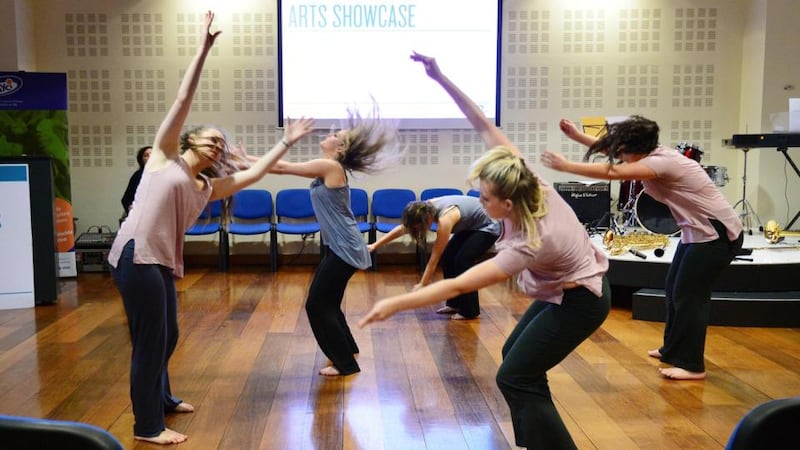How many times have you heard adults say they wish they had not given up playing the piano when they were younger? But when we’re teenagers we won’t be told.
Striving for independence involves casting off childhood commitments such as music lessons, drama rehearsals, ballet classes or art sessions. There are more attractive ways to spend precious time away from school books.
The very accomplished persevere, and some find ways to do it on their own terms, but many teenagers drift away from the arts, due to lack of appealing opportunities to continue.


This is a shame. Participation in the arts can be a lifeline during the turbulence of adolescence – and indeed right through adulthood. It is good for physical and mental health, a means of expression and emotional release as well as a forum for socialising. How do we keep them engaged?
Earlier this month, the National Youth Council of Ireland (NYCI) staged a youth arts showcase for TDs, to highlight that “access to the arts for young people is a right, not a privilege”. In reality, it can be best described as a “postcode lottery” – if we had post codes in Ireland.
There is no standardised provision of youth arts activity across the country, points out Anne O’Gorman, senior arts officer with the NYCI.
"If they live in an area where there doesn't happen to be a youth theatre, or a film or music project, [children] don't get to participate. It becomes harder as they become teenagers."
Positive peer pressure
The chance to enjoy the arts in collaboration with peers can mean the difference between developing a lifelong passion and putting aside the musical instrument, paint brush or dancing shoes for good.
While O’Gorman acknowledges that the education system has an important role in promoting arts, she says “young people leave school at four o’clock: leisure activities and counterpoints to what is happening in school for the rest of your adolescence is really important”.
The previous night she had spent time with young people from arts groups participating in the showcase. A common refrain she heard was: “You get to be with people who like all the same things as you”.
Another aspect, which she admits hadn’t really dawned on her before, is that many teenagers are in single-sex schools so get little chance to mix with the opposite sex if they are not getting opportunities like these.
“Activities outside school have different, complementary outcomes to participating in the arts in school,” she adds. “It is voluntary – it is something you want to do and you are meeting like-minded people.”
Sean McCarron, director of the teenage jazz ensemble Errigal Groove Orchestra, formed two years ago under the auspices of the Donegal VEC's Music Education Partnership, says its members "thrive on the camaraderie and the buzz – it's very infectious. It brings them out of themselves."
These young musicians are at an age when they can feel isolated practising alone, or self-conscious performing solo; they feel “safer”, he suggests, as part of a group. It’s also much more fun.
In formal music lessons it’s “scales, scales, scales . . .” he points out. “We try not to do that. They seem to enjoy the spontaneity.”
The big advantage of youth theatre, as opposed to theatre school, is that the focus is on the young people themselves, says Christina Matthews, artistic director of Droichead Youth Theatre in Drogheda, Co Louth. The company has 38 members, aged 14 to 18, who work on material they want to do.
She knows from experience that if they are not engaged with the subject matter, it is an uphill struggle. “And if they are not committed to the project, they won’t invite their friends.”
There is a focus on social and personal development in youth theatre, she says, but artistic development is also important and “performance is crucial”.
The problem with youth theatre in Ireland is how to get recognition and funding. “Work is being done on a small scale – but how do you get it recognised on a larger scale?” Matthews asks.
The benefits for young people – social, personal and professional – are so obvious to those working in the field, she adds.
Although the Minister for Arts, Heritage and the Gaeltacht, Jimmy Deenihan, described all the performers at the showcase as "living proof of why young people should have access to the arts", he didn't have any good news on the State funding front.
"Funding will not be demolished but it will be reduced," he warned, urging groups to look for alternative sources of income.
Drawn out
There is very little on offer when it comes to the visual arts for teenagers, says Jole Bartoli, the director of Art to Heart, an organisation that provides art courses for children and adults both in educational and community settings. "And what is on offer does not meet their demands."
Teenagers who have enjoyed art as children may find it too solitary an activity as they get older. They might continue if there were more group-oriented opportunities that were not focused so much on technique, she suggests.
“There are many, many subtle elements that put them off,” she says, the main one often being secondary school, where the curriculum puts boundaries on their artistic expression. Gender is also an issue for teenagers, with boys being driven towards more physical leisure activities.
She regrets that art is so often regarded as a “doss” class, with schools and parents pushing for intellectual development. Yet art fosters badly needed creative skills and lateral thinking, while crafts enhance problem-solving skills.
Parents can encourage appreciation of art in many different ways – through observation or occasional visits to galleries or museums.
“It is very delicate in a way because people at that age do not want to be told what to do,” she acknowledges. “But if you do it subtly enough, they remember and they come back.”
swayman@irishtimes.com


















